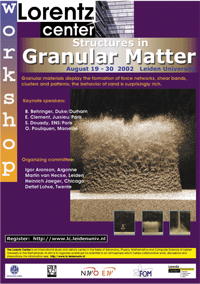Homepage Ko van der Weele
Meteor impact in the lab
To be precise: in the lab of the Physics of Fluids group, Univ. of Twente, The Netherlands,
sponsored by a research grant from FOM: "Granular eruptions: Void collapse and jet formation".
A steel ball
dropped onto loose, very fine sand creates an impressive jet:






Upon impact,
sand is blown away in all directions, forming a crown. The ball dives deep into
the soft sand, creating
a void (like a mine shaft) that immediately collapses again: the pressure
exerted by the sand bed focuses upon the
axis of impact and pushes the sand straight up into the air. In our
experiments, the granular jet always exceeds the
release height of the ball!
 The
granular impact is reminiscent of the more familiar impact on a fluid, and can
be
The
granular impact is reminiscent of the more familiar impact on a fluid, and can
be
described theoretically along roughly the same lines (see Publ. 52, 58).
There also is an intriguing link with the impact of large meteors or asteroids
on a planet.
Even though the absolute size of such an event is hugely different from our
laboratory
experiment, the relative scales
(expressed by the dimensionless Froude and Newton
numbers) are the same. This makes us believe that our experiment is a good
scale model
for giant impacts like the one that killed the dinosaurs 65 million years ago.
The
spectacular pictures of the impact make good cover material. On the poster shown
here they
are used to announce a workshop on Granular Matter at the Lorentz Center in
Leiden, The Netherlands.
Our 3-minute movie "Granular eruptions: void collapse and jet formation"
won the Gallery of Fluid Motion
at the APS Meeting on Fluid Physics, San Diego, USA, 2001. It can be viewed here (with sound, 44 MB).
Homepage Ko
van der Weele